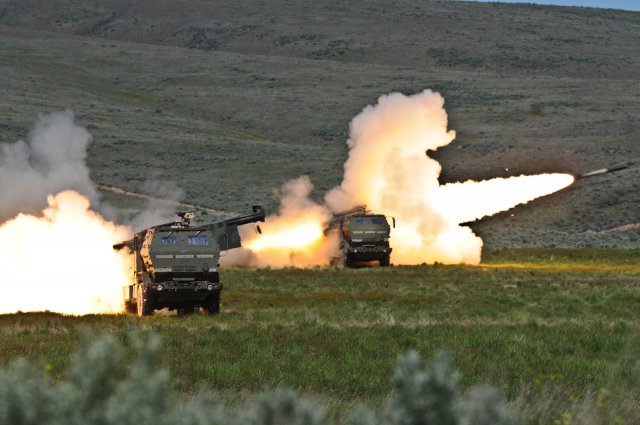Army Needs $45B Of Smart Weapons: Hellfire, GMLRS, ATACMS, Patriot, THAAD

Army HIMARS trucks launch GMLRS (Guided Multiple Launch Rocket System) missiles
ARLINGTON: Against terrorists in Afghanistan, Syria, and Iraq, US forces are firing smart weapons like Hellfire missiles as fast as industry can build them — or faster. Against a well-armed adversary like Russia or China, we might run out. That’s why the military is making a major multi-year investment in precision weapons, one that the Army’s chief logistician estimates at $45 billion for his service alone.
Lt. Gen. Aundre Piggee
“We’re growing our ammunition supplies — and I would tell you this is the one area that keeps me up at night,” said Lt. Gen. Aundre Piggee, the Army’s deputy chief of staff for logistics (G-4), speaking to an Association of the US Army conference here. “If Congress were to give us all the dollars (to fix it) today, it would be about $45 billion.”
“I don’t think that’s possible,” Piggee continued, “and we couldn’t spend it today if they were to give it to us,” because US munitions factories can’t build that much that fast. Instead, he said, the Army, industry, and the joint force have a five-year plan to ramp up spending and production at realistic rates. Work is already underway, he added: “We see this improving every month and getting a little bit better.”
“Precision guided munitions is probably the biggest issue we have,” said Vice Adm. William Brown, logistics direction (J-4) on the Joint Staff, adding the Chairman of the Joint Chiefs is taking a personal interest. “(But) I’m optimistic, because the Army, the Air Force, the Navy, the Marines, they’re putting a lot of money into munitions.”
Vice Adm. William Brown
“We’re looking at the industrial base, getting all the contracts in place, maxing out the production rates, trying to replenish what we’ve expended,” Brown told me after his public remarks. “The services have all stepped up the plate. Over the next five-six years they’re going to have to concentrate on munitions.”
That doesn’t mean we’re sitting ducks today, Brown emphasized. “Have no doubt in your minds that we retain the ability to fight tonight,” he told the conference. Or, as he put it to me later: “My message would be we maintain the ability to put unlimited firepower on any problem….I don’t believe any country can sustain their forces longer and better than we can ours.”
Piggee sounded somewhat more cautious: “We have enough for what we need today, but we’re working to ensure that we have enough to sustain two contingency operations near-simultaneously, and I will tell we are not where we need to be,” he told the conference.
“We are meeting CENTCOM’s requirement” for the current fight, albeit with some difficulty, Piggee told me after his remarks. “(But) we are concerned about a potential future fight, not just the CENTCOM fight,” he continued. “We think we don’t have sufficient for future potential contingencies… with Russia (or) in the Pacific.”
Army Predator variant (MQ-1C Grey Eagle) armed with Hellfire missiles
Different wars would require different types and quantities of weapons. For the current fight in Central Command, Piggee said, the need to avoid collateral damage in urban areas puts particularly heavy stress on stockpiles of two key munitions:
- Hellfire missiles, built by Lockheed Martin. Built as a Cold War anti-tank weapon for AH-64 Apache helicopters, they’re now most famously used by Predator and Reaper drones for precision strikes;
- Guided Multiple Launch Rocket System (GMLRS) rounds, also built by Lockheed Martin. These are a form of precision-guided artillery fired from HIMARS trucks and tracked MLRS vehicles. The House Armed Services Committee has voted to add $13 million to the budget to enhance GMLRS manufacturing. (We haven’t seen comparable details yet from the Senate side).
Patriot missile launch
“We’re using more of those assets now than we did during the surge,” Piggee said. “We try to keep up with CENTCOM. It’s a challenge, (because) they are using more munitions now than they ever did at the height of the surge in the 2008-2009 timeframe…In CENTCOM, we are frankly in some cases exceeding our industrial base (capacity) to maintain.”
And that’s fighting a terrorist group, admittedly an unusually savvy and well-armed one that briefly established its own quasi-state. Against a nation-state with a regular army and a lot of artillery — like Russia, China, or even North Korea — the demand would be even higher. For a major war, said Piggee, the Army would need not only more Hellfires and GMLRS, but also additional supplies of
- ATACMS (Army Tactical Missile Systems), by Lockheed Martin. Like GMLRS, ATACMS can be fired from HIMARS and MLRS vehicles, but it has significantly greater range, as well as an anti-ship variant in development for the Pacific. HASC added $69 million to the budget for 75 additional ATACMS atop the 121 the administration request.
- Patriot missiles (Raytheon). Famed for its shoot-downs of Saddam’s Scuds, Patriot is a defensive weapon that can shoot down incoming enemy aircraft, cruise missiles, and ballistic missiles. Russia, China, and North Korea all boast large inventories of non-nuclear missiles.
- THAAD missiles (Lockheed Martin). Terminal High-Altitude Air Defense is an air and missile defense weapon like the Patriot, but with greater range and higher maximum altitude.
Running out of ammunition has been an American commander’s nightmare since the Battle of Bunker Hill in 1775. Smart weapons were supposed to solve that problem by replacing a whole barrage of inaccurate munitions with a single precise shot. But even with the highest-quality weaponry, it turns out quantity still counts.